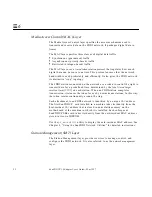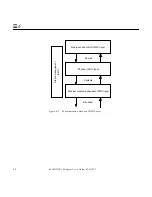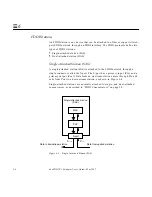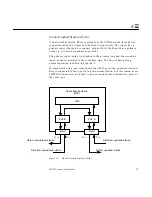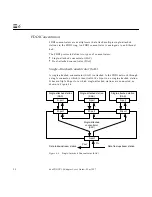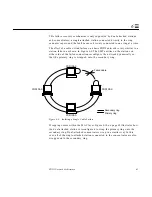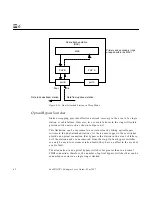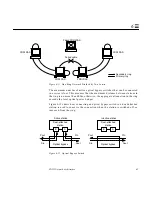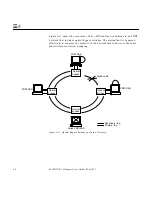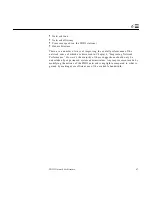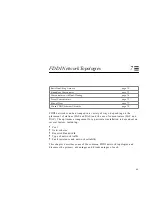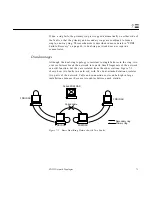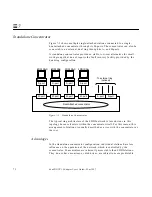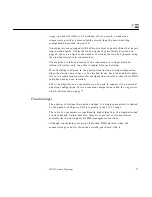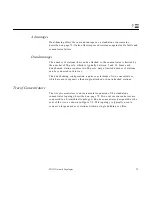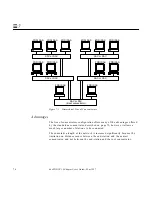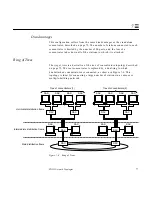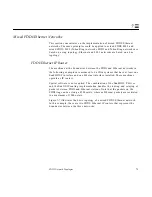
66
SunFDDI/P 1.0 Adapter User’s Guide—May 1997
6
The maximum time for which a station can hold the permission token, and
therefore the time for which a station can transmit on the ring, is determined
by these two station timers that work together to maintain the target token
rotation time (TTRT), irrespective of the load on the network:
•
Token Rotation Timer (TRT)
The TRT measures the time between successive arrivals of the token or, the
time taken for the token to rotate once around the ring. The TRT is reset to
the operating value of TTRT (
T_opr
) each time the token is received. If the
TRT expires before the token arrives, the token is considered late and the
flag
Late_Ct
is set. Only synchronous (high priority) traffic can be
transmitted when
Late_Ct
is set.
•
Token Hold Timer (THT)
The THT determines how long a station can hold a token or, how long a
station can transmit asynchronous traffic. It is loaded with the value
remaining in the token rotation timer (TRT) each time the token arrives.
Thus, the faster the token rotates, the more transmission time is allocated to
each station. If the token is delayed because the network is heavily loaded,
the amount of transmission time is reduced. If THT expires during
transmission, the current transmission is completed before the token is
released.
The interaction of these two timers causes token rotation to increase (reduced
transmission time per station) in a heavily loaded network, and to decrease
(increased transmission time per station) in a lightly loaded network.
FDDI Performance
Although the FDDI standards define a medium that supports data transfer
rates of up to 100 Mbps, this does not translate directly to an increase in overall
system performance. If fact, it frequently transfers the bottleneck elsewhere, so
that the FDDI connection is not used to full capacity.
An FDDI ring has the potential to carry more information rather than to be a
faster connection. If the applications running over the network do not use the
available bandwidth efficiently, you will not see much improvement in the
performance of your network above that of traditional Ethernet connections.
Among the factors that affect FDDI network performance are:
•
Network topology
Содержание 1.0
Страница 13: ...Contents xiii Glossary 141 Index 147 ...
Страница 14: ...xiv SunFDDI P 1 0 Adapter User s Guide May 1997 ...
Страница 18: ...xviii SunFDDI P 1 0 Adapter User s Guide May 1997 ...
Страница 25: ...Part1 InstallingandConfiguring SunFDDI P ...
Страница 26: ......
Страница 36: ...10 SunFDDI P 1 0 Adapter User s Guide May 1997 2 ...
Страница 58: ...32 SunFDDI P 1 0 Adapter User s Guide May 1997 4 ...
Страница 73: ...Part2 PlanningandImplementing SunFDDINetworks ...
Страница 74: ......
Страница 94: ...68 SunFDDI P 1 0 Adapter User s Guide May 1997 6 ...
Страница 110: ...84 SunFDDI P 1 0 Adapter User s Guide May 1997 7 ...
Страница 128: ...102 SunFDDI P 1 0 Adapter User s Guide May 1997 8 ...
Страница 144: ...118 SunFDDI P 1 0 Adapter User s Guide May 1997 9 ...
Страница 150: ...124 SunFDDI P 1 0 Adapter User s Guide May 1997 10 ...
Страница 166: ...140 SunFDDI P 1 0 Adapter User s Guide May 1997 A ...
Страница 172: ...146 SunFDDI P 1 0 Adapter User s Guide May 1997 ...
Страница 182: ......

